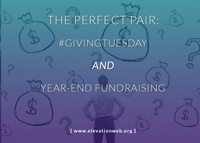Getting visitors to your nonprofit’s online fundraising site isn’t as easy as it sounds, and then trying to convert those visitors into donors is even harder.
The M+R Benchmark Study found that, on average, only 1.1% of website visitors made a donation to a nonprofit. Couple that with the fact that for every 1,000 website visitors, a nonprofit raises $612 and you can see that the nonprofit sector is struggling with conversion.
Source: M+R
Nonprofits need to start capitalizing on the presence of the visitors they already have. By converting those visitors into donors, your nonprofit is bound to increase your donor base and income.
There are a number of reasons why visitors to your website don’t donate. Let’s discuss four of them in detail.
You Don’t Give Them A Reason To Donate
Donors are motivated by their emotions. A well-written story, image, video, or even statistic can do wonders in inspiring and engaging a potential donor. In fact, a study by Yale University found that data doesn’t necessarily result in donations, but stories do! Unfortunately, many nonprofits fail to get visitors emotionally invested in their work.
Give your visitor a reason to donate by providing them with a story that explains your work, its necessity, and highlight someone whose life was changed.
Here are three ways to inspire your website visitors.
- Brush up on your storytelling skills. Feature a powerful client story to detail the impact of your work.
- Use images on your website. Choose visually appealing images of your clients (if appropriate), your staff at work, and the volunteers that you have mobilized.
- Prove your worth with the statistics to back it up. Upload your annual report or an infographic that shows a clear picture of your nonprofit’s work.
World Help’s home page example
Prove to your donor that you’re worth their time and resources by showing them your impact.
They Don’t Know What Their Money Will Do
Nonprofits cannot afford to be vague when it comes to finances because donors today expect full transparency. Millennials, in particular, place a high value on nonprofit transparency when deciding whether to remain engaged with an organization. Just keep in mind that earning a donor’s trust requires you to show them that you can help people and be fiscally responsible at the same time.
Education Fund’s CauseVox online fundraising site
Prove to your website visitors that you have a plan for their money by trying the following:
- Use an impact meter. Let your visitors know how many lives are touched with each dollar, and keep a running tally on your website. That way, they can see a visual representation of their donation.
- Calculate your return on investment (ROI). ROI is as important for nonprofits as it is for businesses. This calculation allows the visitor to see the value of their donation.
- Upload your Form 990. This tax form details a nonprofit’s income and expenses. Sharing your 990 shows transparency and financial stability.
Your donor must get the impression that their donation is going to an organization that handles finances responsibly.
You Don’t Ask
Oftentimes, the biggest problem a nonprofit has in converting visitors into donors isn’t transparency or good storytelling, it’s simply a matter of not asking for a donation, or asking for a donation but not making it easy to follow through.
The M+R Benchmark Study found that the conversion rate averaged 15% for a nonprofit’s main donation page, meaning that nonprofits were drawing people to their primary donation page and failing to “hook” 85% of visitors. That’s a lot of wasted opportunity!
World Bicycle Relief’s 2015 Annual Impact Report
Here are three easy ways to start converting those visitors:
- Make your call to action clear. Let your visitor know exactly what you want from them using actionable words like “Donate,” “Give,” and “Contribute.”
- Express urgency. Your visitors need to know how urgent your need is. Provide them with a timeframe and encourage an immediate donation. “In order to help 10 people, we need to reach 100 donors. Donate now to help someone in need.”
- Use a bold Donate Now button that stands out on the page.
Make it easy for your visitor to give to convert them into donors.
They Just Aren’t Ready
Even if you try every technique under the sun, you still might not be able to convert every visitor into a donor. Sometimes, visitors just aren’t ready to take the leap.
But don’t let this stop you from putting all the pieces in place for that donor. Now may not be the right time, but tomorrow may be. So, prepare your visitor with all the information that they will need to make an informed decision to donate down the road. You can do this by providing them with the opportunity to stay in touch through email, connect on social media, or place them at the start of your donor engagement ladder.
A small but meaningful introduction today may be the beginning of a long-term relationship down the road.







